Commercial Buildings Robots Market Size
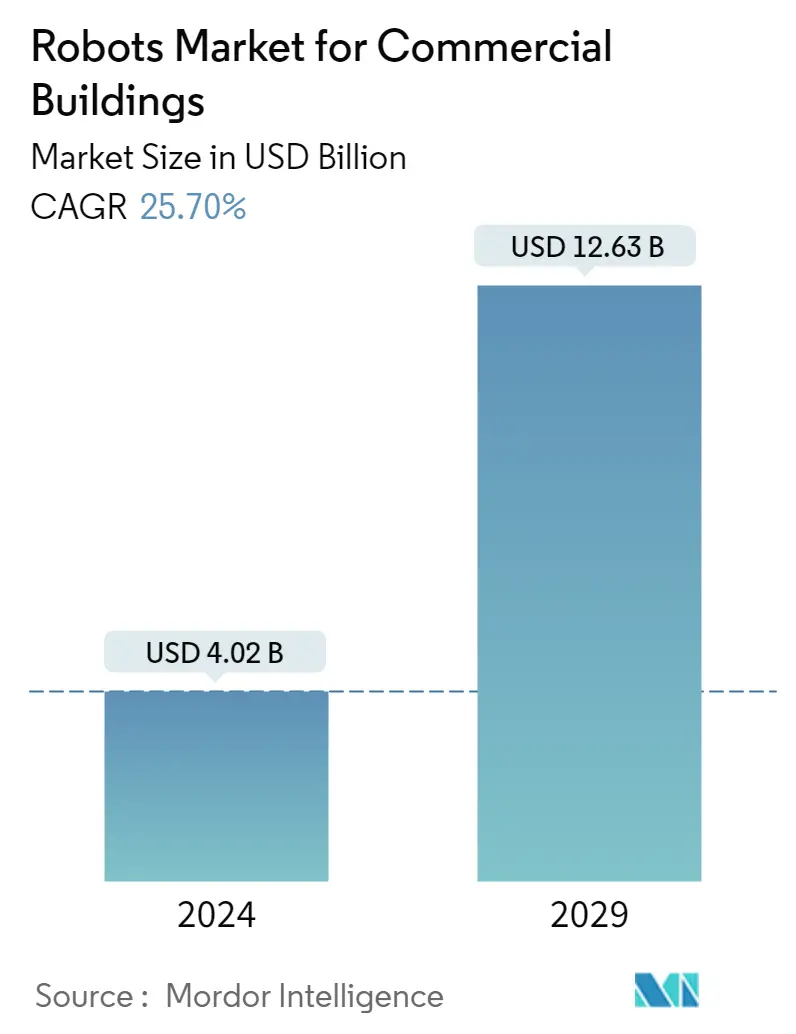
| Study Period | 2019 - 2029 |
| Market Size (2024) | USD 4.02 Billion |
| Market Size (2029) | USD 12.63 Billion |
| CAGR (2024 - 2029) | 25.70 % |
| Fastest Growing Market | Asia Pacific |
| Largest Market | North America |
Major Players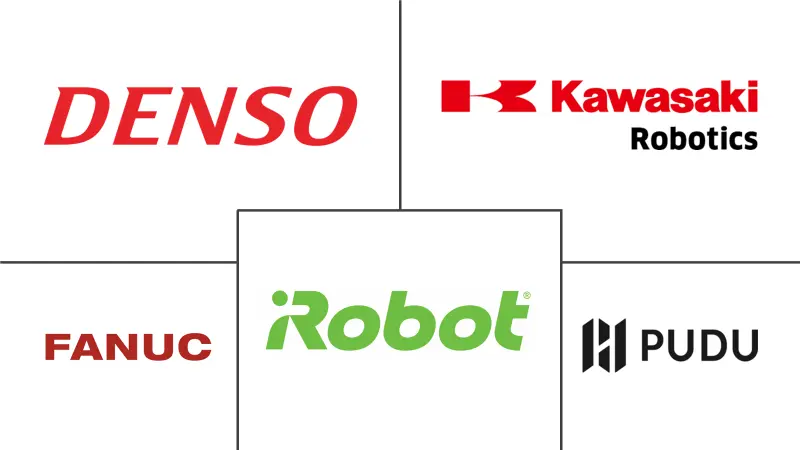
*Disclaimer: Major Players sorted in no particular order |
Commercial Buildings Robots Market Analysis
The Robots Market for Commercial Buildings Industry is expected to grow from USD 4.02 billion in 2024 to USD 12.63 billion by 2029, at a CAGR of 25.70% during the forecast period (2024-2029).
- The increasing technological developments and the ongoing labor shortage encourage facility management companies to switch to automated tools for higher cleanliness, service, and technological capabilities.
- Automation and AI technology have transformed many industries, from healthcare to banking to retail, and while commercial buildings were not early adopters, they are definitely another industry beginning to benefit from advanced technology for improving efficiency.
- Commercial robots are widely used for cleaning tasks such as sweeping, mopping, and vacuuming. These robots can be programmed to clean specific areas at specific times, reducing labor costs and improving efficiency.
- Serving robots are also becoming increasingly popular in restaurants, as they provide improved efficiency, contactless service, increased capacity, and are cost-effective. These robots can carry multiple dishes or drinks at once, which helps speed up service and reduce wait times for customers.
- Due to such reasons, various vendors regularly make technological advancements and focus on strategic investments to expand their product offerings and cater to varying customer needs. For instance, in February 2023, Kum & Go announced a partnership with ICE Cobotics to deploy automated floor-cleaning robots. By integrating the autonomous equipment, the brand will help free up associates from repetitive work and allow them to focus on keeping shelves and coolers fully stocked, delivering fresh food offerings, and increasing engagement with in-store customers.
Commercial Buildings Robots Market Trends
Floor Cleaning Robots Expected to Have a Major Share
- Floor-cleaning robots are autonomous devices designed to clean floors without human intervention. These robots use various technologies, such as sensors, mapping algorithms, and cameras, to navigate around the room and clean floors. These robots typically have brushes and vacuum suction to clean dirt and debris from floors.
- Commercial floor cleaning robots free up cleaning staff for other tasks that can't be automated and help to maximize employees' productivity and efficiency so that the cleaning staff has more time to focus on the tasks that only humans can do.
- Moreover, the primary factor driving the demand for robot floor cleaning is its convenience. With busy lifestyles, people are looking for easy and efficient ways to maintain their homes, and robot floor cleaners offer a hassle-free cleaning experience without requiring much human intervention.
- Floor-cleaning robots are widely used in airports to clean high-traffic areas, such as terminal entrances, security checkpoints, and baggage claim areas. These areas accumulate a lot of dirt, which these robots can efficiently remove.
- Due to such reasons, various airports are deploying floor-cleaning robots. For instance, in December 2022, the Hawaii Department of Transportation's Airports Division modernized the Daniel K. Inouye International Airport with two automatic floor cleaners to supplement janitorial services. An average of 73,000 arrivals walk through the Daniel K. Inouye International Airport daily. Such a high daily footfall creates a need for autonomous cleaning robots.
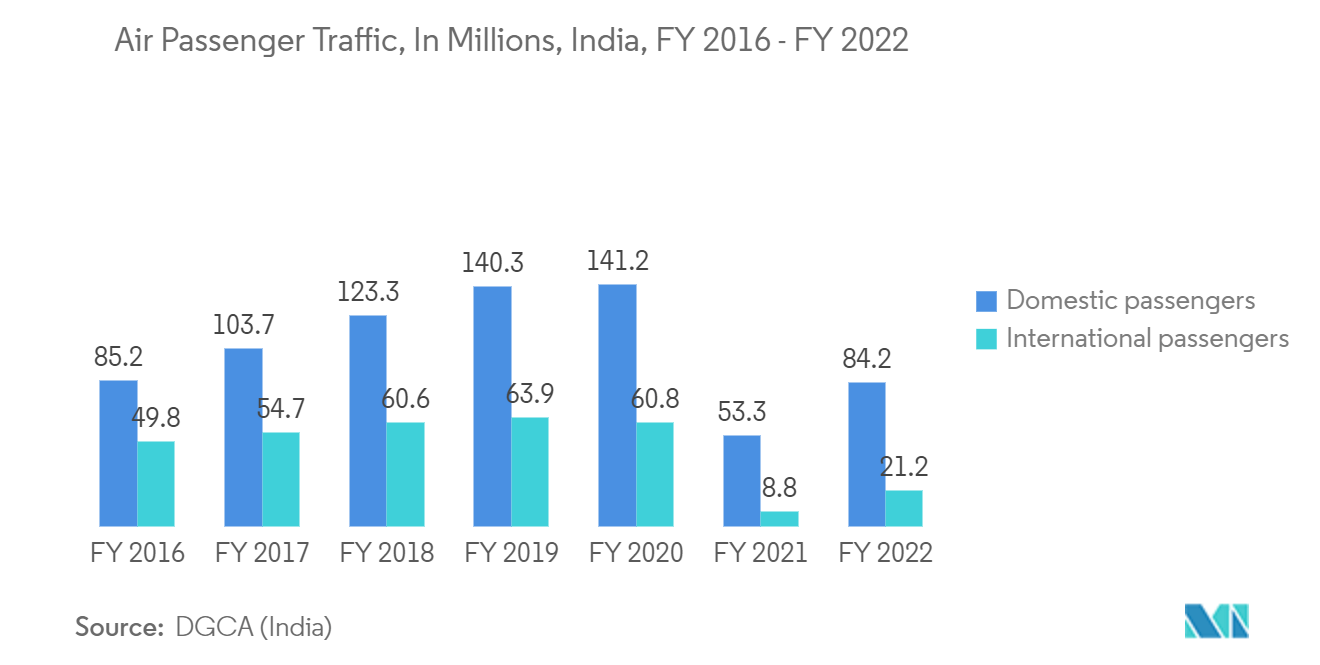
North America to Account for Major Market Share
- North America is one of the largest and most advanced markets for robotic solutions in the world. The strong economy, with notable airport traffic, increased use of cleaning robots in retail and hospitals, and the use of servicing robots in the hospitality sector, is poised to drive the demand for commercial robots in the country.
- Robots in commercial buildings are becoming increasingly popular in the region, as many households and businesses are investing in these technologies to make serving, cleaning, and disinfecting tasks more efficient and less time-consuming.
- Cleaning robots help improve health and safety by reducing exposure to harmful cleaning chemicals and allergens. They also reduce the risk of slips, trips, and falls by keeping floors and surfaces clean and dry.
- According to the National Institute for Occupational Safety and Health, chemical exposure in the workplace is one of the most significant problems in the United States. Over 13 million workers in the country are potentially exposed to chemicals through their skin. Skin disorders are among the most significantly reported occupational diseases, resulting in an estimated annual cost of over USD 1 billion in the United States.
- Due to such reasons, various vendors operating in the region are focusing on developing innovative solutions. For instance, in September 2022, iRobot Corporation introduced a Roomba Combo j7+, a 2-in-1 robot vacuum, and a mop with iRobot OS 5.0 updates. The Roomba Combo j7+ vacuums rugs and carpets first and then vacuums and mops hard floors concurrently, saving users time by cleaning the area in a single job.
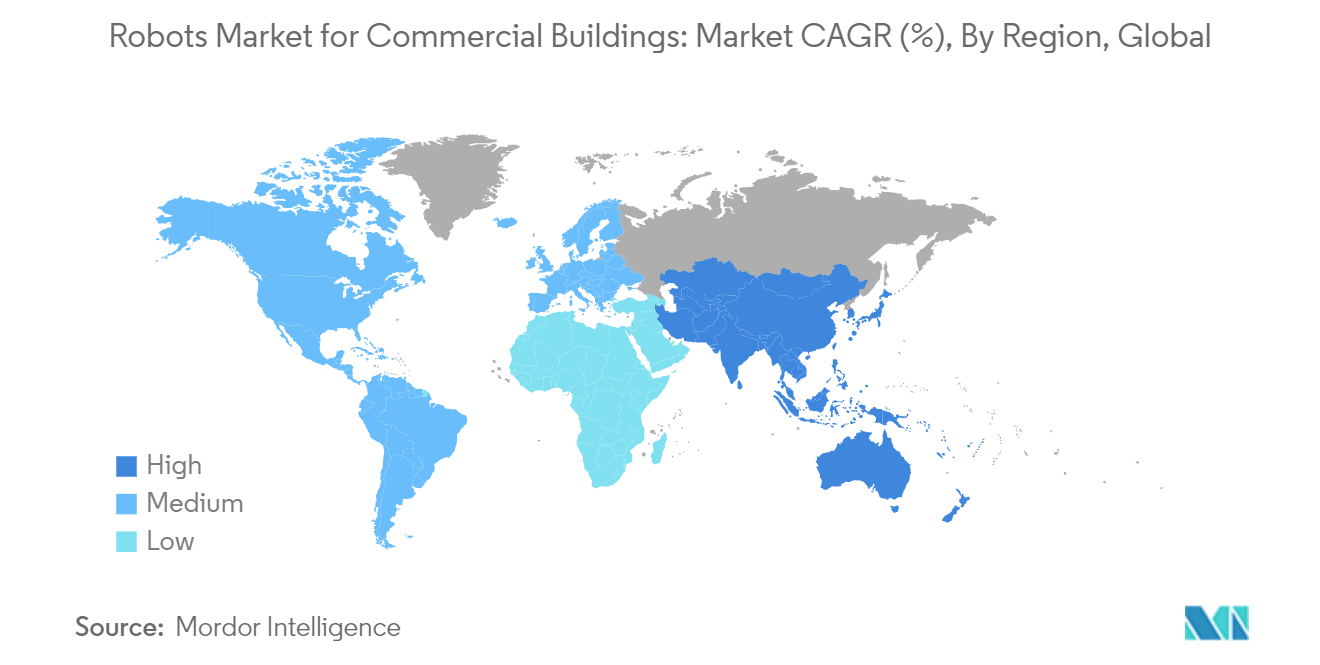
Commercial Buildings Robots Industry Overview
The robots market for commercial buildings is highly fragmented and consists of many competitive players. In terms of market share, a few major players, such as iRobot Corporation, Omron Adept Technologies Inc., and Pudu Robotics, currently dominate the market. These major players with a significant share of the market are expanding their customer base across the region. Many companies are forming strategic and collaborative initiatives with various start-ups to increase their market share and profitability.
In February 2023, Pudu Robotics, a leading restaurant service robotics manufacturer based in China, completed its Series C funding round to raise more than USD 15 million. The company will use the funds to build a production base, expand production capacity, and develop products for commercial cleaning scenarios.
In October 2022, ECOVACS, one of the leading cleaning robotics companies, announced the launch of two new smart robots. Adding to its global lineup of robotic cleaning products, including DEEBOT robotic home floor cleaners, WINBOT window and surface cleaners, and AIRBOT air purifying robots, the additions expand the robotic cleaning category with ECOVACS.
Commercial Buildings Robots Market Leaders
-
iRobot Corporation
-
Pudu Robotics
-
Denso Corporation
-
Fanuc Corporation
-
Kawasaki Robotics GmbH
*Disclaimer: Major Players sorted in no particular order
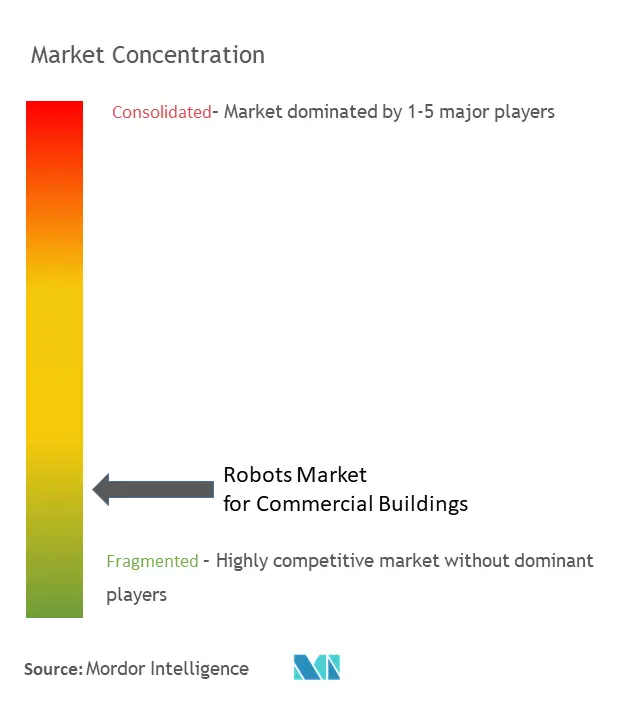
Commercial Buildings Robots Market News
- January 2023: Pudu Robotics, a service robot manufacturer, deployed its robotic solutions in more than 600 cities worldwide as of the end of 2022. The company aims to expand its services and use cases in 2023. To bring its robots to more industries, PUDU has partnered with several major hotel brands, including Marriott and Hilton. PUDU's robots have also been used at restaurants, shopping malls, convenience stores, and office buildings.
- September 2022: Magna and Cartken, a San Francisco-based autonomous robotics company, announced an agreement to manufacture Cartken's autonomous delivery robot fleet to meet the growing demand for last-mile delivery. The company is expected to manufacture robots at a Magna facility in Michigan.
Robots Market for Commercial Buildings Market Report - Table of Contents
1. INTRODUCTION
- 1.1 Study Assumptions and Market Definition
- 1.2 Scope of the Study
2. RESEARCH METHODOLOGY
3. EXECUTIVE SUMMARY
4. MARKET INSIGHTS
- 4.1 Market Overview
-
4.2 Industry Attractiveness - Porter's Five Forces Analysis
- 4.2.1 Bargaining Power of Buyers/Consumers
- 4.2.2 Bargaining Power of Suppliers
- 4.2.3 Threat of New Entrants
- 4.2.4 Threat of Substitute Products
- 4.2.5 Intensity of Competitive Rivalry
- 4.3 Industry Value Chain Analysis
5. MARKET DYNAMICS
-
5.1 Market Drivers
- 5.1.1 Increasing Government Initiatives for Robot Research
- 5.1.2 Various Business Models, Such As Leasing and Robot-as-a-Service
-
5.2 Market Restraints
- 5.2.1 High Product Cost
- 5.2.2 Lack of Customer Awareness
6. MARKET SEGMENTATION
-
6.1 Type of Robots
- 6.1.1 Floor Cleaning Robots
- 6.1.2 Disinfection Robots
- 6.1.3 Retail Shelf Management Robots
- 6.1.4 Serving Robots
- 6.1.5 Building Service Robots
-
6.2 End-user Verticals
- 6.2.1 Retail
- 6.2.2 Restaurants
- 6.2.3 Healthcare Facilities
- 6.2.4 Airports
- 6.2.5 Other End-user Verticals
-
6.3 Geography
- 6.3.1 North America
- 6.3.2 Europe
- 6.3.3 Asia-Pacific
- 6.3.4 Latin America
- 6.3.5 Middle East and Africa
7. COMPETITIVE LANDSCAPE
-
7.1 Company Profiles
- 7.1.1 iRobot Corporation
- 7.1.2 Pudu Robotics
- 7.1.3 Denso Corporation
- 7.1.4 Fanuc Corporation
- 7.1.5 Kawasaki Robotics GmbH
- 7.1.6 Kuka AG
- 7.1.7 Mitsubishi Electric Corporation
- 7.1.8 SoftBank Robotics Corp
- 7.1.9 Ecovacs Robotics
- 7.1.10 ABB Ltd.
- 7.1.11 Nachi Fujikoshi Corporation
- 7.1.12 Diversey
- 7.1.13 Yaskawa Electric Corporation
- 7.1.14 Samsung Electronics Co Ltd.
- 7.1.15 Vorwerk & Co. KG
- *List Not Exhaustive
8. INVESTMENT ANALYSIS
9. FUTURE OUTLOOK OF THE MAREKET
** Subject To AvailablityCommercial Buildings Robots Industry Segmentation
Robots manage many of the core operations in commercial applications, which is crucial. The use of robots in commercial buildings has witnessed a surge in demand in the past decade. This is due to the rising convergence of robotics and artificial intelligence, including planning and search, probabilistic inference, localization, tracking, and control.
The scope of the report includes the use of different kinds of robots in commercial buildings based on their type and their applications in commercial buildings. The study also tracks the key market parameters, underlying growth influencers, and major vendors operating in the industry, which supports the market estimations and growth rates over the forecast period. The study further analyzes the overall impact of COVID-19 on the ecosystem. The robots market for commercial buildings is segmented by type of robots (floor cleaning robots, disinfection robots, retail shelf management robots, serving robots, building service robots), end-user vertical (retail, restaurants, healthcare facilities, airports), and geography (North America, Europe, Asia-Pacific, Latin America, Middle East and Africa). The market sizes and forecasts are provided in terms of value (USD) for all the above segments.
| Type of Robots | Floor Cleaning Robots |
| Disinfection Robots | |
| Retail Shelf Management Robots | |
| Serving Robots | |
| Building Service Robots | |
| End-user Verticals | Retail |
| Restaurants | |
| Healthcare Facilities | |
| Airports | |
| Other End-user Verticals | |
| Geography | North America |
| Europe | |
| Asia-Pacific | |
| Latin America | |
| Middle East and Africa |
Robots Market for Commercial Buildings Market Research Faqs
How big is the Commercial Buildings Robots Market?
The Commercial Buildings Robots Market size is expected to reach USD 4.02 billion in 2024 and grow at a CAGR of 25.70% to reach USD 12.63 billion by 2029.
What is the current Commercial Buildings Robots Market size?
In 2024, the Commercial Buildings Robots Market size is expected to reach USD 4.02 billion.
Who are the key players in Commercial Buildings Robots Market?
iRobot Corporation, Pudu Robotics, Denso Corporation, Fanuc Corporation and Kawasaki Robotics GmbH are the major companies operating in the Commercial Buildings Robots Market.
Which is the fastest growing region in Commercial Buildings Robots Market?
Asia Pacific is estimated to grow at the highest CAGR over the forecast period (2024-2029).
Which region has the biggest share in Commercial Buildings Robots Market?
In 2024, the North America accounts for the largest market share in Commercial Buildings Robots Market.
What years does this Commercial Buildings Robots Market cover, and what was the market size in 2023?
In 2023, the Commercial Buildings Robots Market size was estimated at USD 3.20 billion. The report covers the Commercial Buildings Robots Market historical market size for years: 2019, 2020, 2021, 2022 and 2023. The report also forecasts the Commercial Buildings Robots Market size for years: 2024, 2025, 2026, 2027, 2028 and 2029.
Robots for Commercial Buildings Industry Report
Statistics for the 2024 Robots for Commercial Buildings market share, size and revenue growth rate, created by Mordor Intelligence™ Industry Reports. Robots for Commercial Buildings analysis includes a market forecast outlook to for 2024 to 2029 and historical overview. Get a sample of this industry analysis as a free report PDF download.



